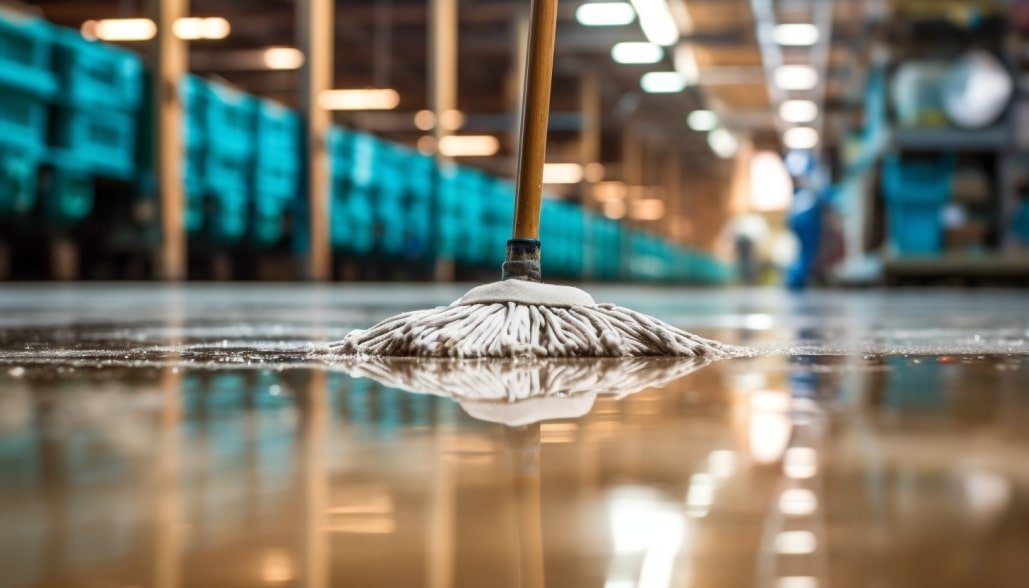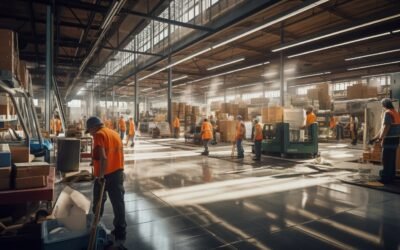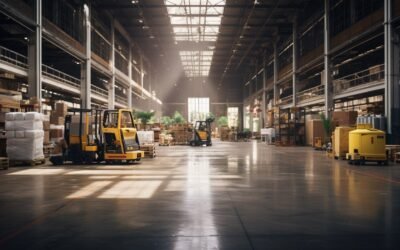In the bustling world of warehouse operations, cleanliness and safety are paramount. One of the most common and overlooked issues is warehouse floor stains. These seemingly innocuous spots can be a sign of deeper problems, from chemical spills to rusting machinery. Understanding these stains, their causes, and how to tackle them effectively is crucial for maintaining a safe, efficient warehouse environment. This guide will delve into the common types of warehouse floor stains, the challenges they present, and the best practices for dealing with them in the context of Canadian law and businesses. Let’s embark on this journey to conquer the stain challenge and create a cleaner, safer warehouse space.
Table of Contents
Understanding Warehouse Floor Stains
Warehouse floors are the unsung heroes of the industrial world. They bear the weight of heavy machinery, endure the constant traffic of forklifts, and resist the onslaught of chemical spills. Over time, these factors can lead to various types of stains, each with its unique challenges.
The first step in tackling these stains is understanding their nature. Oil and grease stains, for instance, are common in areas where vehicles and machinery are frequently used. They can make the floor slippery, posing a safety hazard. Chemical stains, on the other hand, may result from spills of substances like acids or solvents. These stains can cause damage to the floor material and may even pose health risks. Rust stains are another common type, often caused by metal objects or machinery. They can be a sign of underlying corrosion that needs to be addressed.
Identifying these stains is not always straightforward. Visual cues can help, but they are not always reliable. For instance, oil stains may appear darker than the surrounding area, while rust stains may have a reddish-brown color. However, the appearance can vary depending on factors like the age of the stain and the type of floor material. The location and source of the stain can provide additional clues. For instance, a stain near a machine might be oil or grease, while a stain near a storage area for chemicals might be a chemical stain.
Understanding these stains and their causes is the first step towards effective management. It allows for targeted cleaning strategies and preventive measures, reducing the risk of damage to the floor and potential safety hazards.
Key Takeaway: Understanding the nature and causes of warehouse floor stains is crucial for effective management. Identifying the type of stain can guide the cleaning process and help in implementing preventive measures.
Challenges in Dealing with Warehouse Floor Stains
Dealing with warehouse floor stains is not without its challenges. One of the main hurdles is finding suitable cleaning solutions. Not all stains are created equal, and what works for one type of stain may not work for another. For instance, oil and grease stains may require degreasing agents, while rust stains may require specific rust removers.
Another challenge is preventing stains from recurring. This often involves regular maintenance and preventive measures, such as using floor mats in high-traffic areas and ensuring proper storage of chemicals. However, these measures can be time-consuming and require ongoing effort.
In addition to these practical challenges, there are also legal considerations. In Canada, businesses are required to maintain a safe working environment, which includes keeping the warehouse floor clean and free from hazards. Failure to comply with these regulations can result in penalties, adding another layer of complexity to the stain management process.
Despite these challenges, effective stain management is achievable with the right knowledge and strategies. The key is to understand the nature of the stains, use appropriate cleaning solutions, and implement preventive measures to reduce the risk of recurrence.
Key Takeaway: Dealing with warehouse floor stains involves practical and legal challenges. Understanding the nature of the stains, using appropriate cleaning solutions, and implementing preventive measures can help overcome these challenges.
Finding Suitable Cleaning Solutions
Finding the right cleaning solution for warehouse floor stains can be a daunting task. The market is flooded with a plethora of products, each claiming to be the best. However, the effectiveness of a cleaning solution largely depends on the type of stain it is designed to tackle.
For oil and grease stains, degreasing agents are often the go-to choice. These products work by breaking down the oil or grease, making it easier to remove. Some popular degreasers include Simple Green and Zep Commercial Heavy-Duty Floor Stripper.
Chemical stains, on the other hand, can be more challenging. They may require specialized cleaning agents that can neutralize the chemical and remove the stain without damaging the floor. In some cases, professional cleaning services may be needed.
Rust stains can be particularly stubborn. They often require rust removers, which contain acids that react with the rust to dissolve it. However, these products must be used with caution, as they can also damage the floor if not used correctly.
Preventing stains from recurring is another challenge. Regular cleaning and maintenance can help, but it’s also important to address the root causes of the stains. For instance, if oil stains are a recurring problem, it may be necessary to check the machinery for leaks and fix any issues. Similarly, if chemical spills are causing stains, proper storage and handling of chemicals can help prevent future spills.
Key Takeaway: Finding the right cleaning solution for warehouse floor stains requires understanding the nature of the stain and choosing a product designed to tackle that type of stain. Preventing stains from recurring involves regular maintenance and addressing the root causes of the stains.
Tackling Warehouse Floor Stains in Canada
In the Canadian context, dealing with warehouse floor stains involves additional considerations. The country’s laws and regulations impose certain requirements on businesses, and local solutions may be more accessible and cost-effective.
Legal Considerations
In Canada, businesses are required to maintain a safe working environment under the Occupational Health and Safety Act. This includes keeping the warehouse floor clean and free from hazards. Stains can make the floor slippery or hide other hazards, so they need to be addressed promptly.
Failure to comply with these regulations can result in penalties. For instance, businesses can be fined for violations, and in serious cases, they may even be shut down. Therefore, it’s crucial for businesses to understand their legal obligations and ensure they are in compliance.
Local Solutions
When it comes to cleaning solutions and services, local options can often be more accessible and cost-effective. Canadian businesses have access to a range of local products and services designed to tackle warehouse floor stains.
For instance, CLR is a popular Canadian brand that offers a range of cleaning products, including degreasers and rust removers. For professional cleaning services, companies like COIT offer commercial floor cleaning services across Canada.
In addition to these, there are also local resources and organizations that can provide guidance and support. For instance, the Canadian Centre for Occupational Health and Safety offers resources on workplace safety, including guidelines on maintaining clean and safe floors.
Key Takeaway: In Canada, dealing with warehouse floor stains involves legal considerations and the use of local solutions. Businesses need to comply with safety regulations and can benefit from local products and services.
Routine Maintenance
Routine maintenance is key to preventing warehouse floor stains. This involves regular cleaning to remove any spills or debris that could cause stains. A cleaning schedule can help ensure that cleaning is done regularly and not overlooked.
Recommended products for routine maintenance include neutral floor cleaners, which are designed to clean without damaging the floor. These can be used for daily or weekly cleaning, depending on the level of traffic and the type of activities in the warehouse.
Safety Measures
Safety measures are also crucial in preventing stains. This includes using protective gear when handling chemicals to prevent spills, and using floor mats in high-traffic areas to absorb spills and prevent stains.
Proper storage of chemicals is also important. Chemicals should be stored in a designated area with a spill containment system to prevent spills from spreading and causing stains.
Key Takeaway: Routine maintenance and safety measures are crucial in preventing warehouse floor stains. This includes regular cleaning, using protective gear, and proper storage of chemicals.
Preventive Measures and Best Practices
Preventing warehouse floor stains is not just about cleaning. It’s about implementing a comprehensive strategy that includes routine maintenance, safety measures, and best practices tailored to your specific warehouse environment.
Routine Maintenance
Routine maintenance is the backbone of stain prevention. This involves regular cleaning of the warehouse floor to remove any potential staining agents before they can cause damage. Depending on the nature of your warehouse operations, you may need to schedule daily, weekly, or monthly cleanings.
For routine cleaning, consider using a neutral pH cleaner. These cleaners are gentle on most floor materials and can effectively remove dirt and minor stains. Brands like Eco-Max offer a range of eco-friendly, neutral pH cleaners that are made in Canada.
Remember, routine maintenance is not just about cleaning. It’s also about inspection. Regularly inspect your warehouse floor for signs of stains or damage. Early detection can make stain removal easier and prevent minor issues from turning into major problems.
Safety Measures
Safety measures are another key aspect of stain prevention. This includes proper handling and storage of materials that could cause stains.
For instance, oils and chemicals should be handled with care to prevent spills. Workers should be trained on safe handling procedures and provided with appropriate protective equipment. In case of a spill, it should be cleaned up immediately to prevent it from soaking into the floor and causing a stain.
Proper storage is also crucial. Materials should be stored in appropriate containers and in designated areas. Spill containment systems, such as drip pans or spill pallets, can be used to catch leaks and prevent spills from spreading.
Best Practices
In addition to routine maintenance and safety measures, there are several best practices that can help prevent warehouse floor stains.
One of these is to use floor mats in high-traffic areas and areas where spills are likely, such as near machinery or storage areas. Floor mats can absorb spills and prevent them from soaking into the floor.
Another best practice is to seal your warehouse floor. Floor sealers can provide a protective barrier that prevents staining agents from soaking into the floor. There are various types of floor sealers available, so you can choose one that is suitable for your floor material and the types of stains you are likely to encounter.
Key Takeaway: Preventing warehouse floor stains involves a combination of routine maintenance, safety measures, and best practices. By implementing a comprehensive prevention strategy, you can keep your warehouse floor clean and stain-free.
Checklist for daily, weekly and monthly cleaning of a commercial warehouse
Here is a checklist for daily, weekly, and monthly cleaning of a commercial warehouse:
Daily Warehouse Cleaning Checklist:
- Wipe down countertops with disinfectant solution.
- Empty garbage cans and waste baskets.
- Wipe down equipment and check for safety and condition.
- Check the condition of shelves and storage areas.
- Clean bathrooms.
- Wipe countertops, sinks, and high contact areas.
- Scrub toilet with toilet brush and cleaning solution.
- Mop floors with disinfectant solution.
- Refill toilet paper, tissues, and soap.
Weekly Warehouse Cleaning Checklist:
- Sweep floors.
- Empty trash cans.
- Straighten workspaces.
- Confirm shelf and pallet safety.
- Clear passageways between shelves and stacks.
- Recycle excess packaging and waste materials.
Monthly Warehouse Cleaning Checklist:
- Deep clean floors: Shampoo carpeting, steam clean hard surface floors.
- Scrub the walls clean.
- Check entryway mats for wear.
- Power washing of landings, walkways, loading docks, and steps.
- Shampoo and condition carpets.
- Spot-clean any stains on fabric furniture.
- Vacuum under, inside, and behind desks, sofas, etc.
It’s important to note that this is a general checklist and may need to be adjusted based on the specific needs and requirements of your warehouse. Regular cleaning and maintenance are essential for maintaining a clean and safe working environment.
Conquering the Stain Challenge: A Cleaner Warehouse Awaits
Having armed yourself with the knowledge of different types of warehouse floor stains, the challenges they present, and the strategies to tackle them, you are now ready to conquer the stain challenge. The journey may seem daunting, but remember, every step you take towards maintaining a clean and safe warehouse environment is a step towards efficiency and productivity.
In Canada, the journey is made easier with the availability of local solutions and the guidance provided by Canadian laws and regulations. From local brands offering effective cleaning products to professional cleaning services that understand the unique needs of Canadian businesses, you have a wealth of resources at your disposal.
But the journey doesn’t end here. The world of warehouse operations is dynamic, and new challenges can arise at any time. Stay informed, stay prepared, and continue to adapt your strategies as needed. Remember, a cleaner warehouse is not just about aesthetics. It’s about safety, efficiency, and creating a work environment that your team can be proud of.
Key Takeaway: Conquering the stain challenge is a continuous journey. With the right knowledge, strategies, and resources, you can maintain a clean and safe warehouse environment that boosts efficiency and productivity.
Frequently Asked Questions
What are the most common types of warehouse floor stains in Canada?
The most common types of warehouse floor stains in Canada are oil and grease stains, chemical stains, and rust stains. These can result from various sources, including machinery, chemical spills, and metal objects.
How can I identify different types of stains?
Identifying different types of stains can be challenging, but there are some clues you can look for. The appearance of the stain, its location, and the source can all provide hints about the type of stain.
What are some effective cleaning solutions available in Canada?
There are many effective cleaning solutions available in Canada. For oil and grease stains, degreasers like Simple Green or Zep Commercial Heavy-Duty Floor Stripper can be effective. For rust stains, rust removers like CLR can be used. For chemical stains, you may need specialized cleaning agents or professional cleaning services.
How can I prevent stains from recurring?
Preventing stains from recurring involves regular maintenance and preventive measures. This includes regular cleaning, using protective gear when handling chemicals, using floor mats in high-traffic areas, and proper storage of chemicals.
What are the legal considerations when dealing with warehouse floor stains in Canada?
In Canada, businesses are required to maintain a safe working environment, which includes keeping the warehouse floor clean and free from hazards. Failure to comply with these regulations can result in penalties.
Sources
- “Simple Green Household Cleaning Site.” Simplegreen.com, 2023, simplegreen.com/. Accessed 20 July 2023.
- “Zep Canada.” Zep Canada, 29 Nov. 2021, canada.zep.com/. Accessed 20 July 2023.
- “Occupational Health and Safety Regulation – WorkSafeBC.” Worksafebc.com, 2019, www.worksafebc.com/en/law-policy/occupational-health-safety/searchable-ohs-regulation/ohs-regulation. Accessed 20 July 2023.
- “CLR® Calcium, Lime, & Rust Remover.” Clrbrands.com, 2022, clrbrands.com/Products/CLR-Household/CLR-Calcium-Lime-and-Rust-Remover. Accessed 20 July 2023.
- Canada. “COIT.” COIT, 16 Mar. 2021, ca.coit.com/. Accessed 20 July 2023.
- Canada,. “Canadian Centre for Occupational Health and Safety.” Ccohs.ca, 2023, www.ccohs.ca/. Accessed 20 July 2023.
- “Eco-Max – the Natural Choice for Healthy Cleaning.” Eco-Max, 9 May 2023, eco-max.com/. Accessed 20 July 2023.








